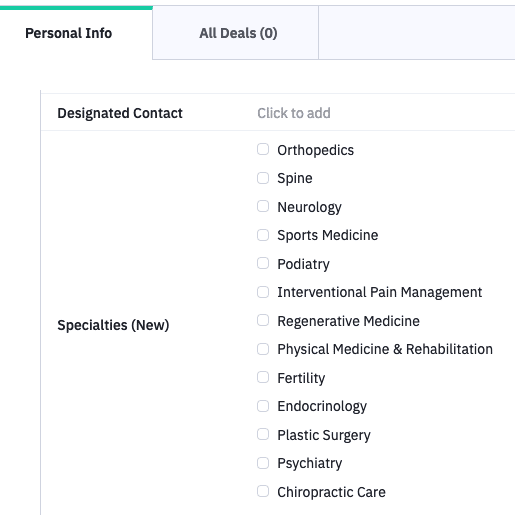One of the best features of a data management tool, whether a surgical dashboard, customer relationship management system (CRM), or other reporting tool, is the ability to customize your options. Even most off-the-shelf solutions offer some level of customization to help manage your data in a way that is efficient and makes sense for your company.
With that said, customization can also be a big downfall if you aren’t thoughtful about what your company needs now and what they will need in the future. Are you collecting too much data, or not enough? Are the ways in which you collect or display data actually useful? This is where things can get messy if you don’t think things through and regularly reevaluate your needs.
This is something we’ve experienced ourselves with our CRM tool. While we use an off-the-shelf solution, there are several opportunities to add custom fields to capture company-specific data about our clients. However, the way that the custom fields were initially set up did not scale well over the years as we’ve grown and evolved as a company. This has led to a lot of very time-consuming cleanup that had to be done to make the system useful for us today. Now, we’d like to share what we have learned from this experience with you, and how you can apply it to your own custom dashboard processes.
1. Think about how you might use the data before deciding how to collect and present it.
In our CRM, we house client data for both our Health Connective company and our sister-company, P3 Practice Marketing. While we started off primarily working with practices and companies in the orthopedic space, we’ve since expanded to other medical specialties. As we’ve expanded, we’ve had some instances where it would have been useful to filter our contacts by specialty. We did add a custom field to our CRM that would allow us to note specialty, but it was a text-input field, which is not conducive to filtering. Anytime you allow people to input information in their own words, you are going to have a lot of variations that would make it impossible to filter the data down.
Instead, to be able to facilitate the filtering we needed, we had to go back and change the custom field to a static field with a set number of options for specialty. This helped to standardize the information being collected so that we could filter and build the right contact lists for our customers. However, since we didn’t think of that need until after we had collected thousands of contacts over many years, we had to go back and manually update all of those contacts with the new static options. That was not a fun undertaking by any means.

For our customers with surgical dashboards, they have to consider what data they will actually need to use. Surgical robots generate a tremendous amount of data. While it would be possible to get all of that into a dashboard, the people using that data almost never want that much information. Developers can take the processed data and feed it through tools like Qubole, Tableau, or raw python scripts to extract or filter down to the data your users care about. Only including the necessary data makes for a more streamlined experience so your key users can find what they are looking for.
So, as you are considering your options for customization, think through how you might actually use the data before you commit to how you collect and present it. It could save you a ton of work in the future.
2. Make sure you address your needs now, but also think about what you might need in the future.
Whether fully custom or off-the-shelf, you definitely need to make sure that the solution you choose will be useful for you now. However, it’s also important to think about how your needs might change in the future. Is your solution adaptable to different needs, or will you have to start over again once you’ve outgrown what you have set up?
For our CRM overhaul, we made a move toward more static fields and less text-input boxes. Not only does this support our filtering needs, but also it’s easy to edit the static fields to add on more options down the line if needed, without messing up or having to re-do what we currently have in place. The more you can do to make your custom options easily-adaptable for future needs, the better off you will be.
For a custom application, that might mean discussing with your developers from the start about what kind of lift it would take if you find you need to present more or less information in the future, or need to present information in a different way. Once people actually begin using the dashboard, you may find that your initial assumptions about user needs were incorrect, or you may have a new dataset to include in the future. To plan for that as much as possible, you should have that discussion with your developers at the beginning so they can build the initial iteration of the dashboard to be as flexible as possible.
3. Consider scalability–will your solution work as well with a large set of data as it will with a small dataset?
Our issue with the way we were recording specialty information for our clients stems in part from the fact that we weren’t thinking about how it might work when we grew as a company. We started off in one specialty, so there wasn’t as much of a need to segment and filter our client lists. And in the few cases where we did need to segment, it was only a matter of manually excluding the few contacts that didn’t need to be included. However, as our client base grew more diverse, it became more of a pain to segment our client data in the way we needed to. This led to a very time-consuming overhaul to structure our data in a way that would make it efficient for our team to use the CRM.
When we were initially onboarding with the CRM we currently use, we also got a bit overzealous with data collection, again because we had a smaller set of data back then. It wasn’t a big deal to create all of these custom fields and capture every single bit of information we could possibly know about each client. Then, as we grew, we found that it just wasn’t feasible to fill in that much information for each client’s profile every time we brought on a new customer. A lot of that information was never used or referenced again after the initial profile buildout, and a lot of it ended up becoming outdated as details changed if no one thought to go in and update it. So, we went back to the drawing board, eliminated the unnecessary custom fields, and established clear processes for updating client profiles so things would stay up to date.
Likewise, with all of the data a surgical robot can capture, it’s important to only feed data into the dashboard that’s useful to the people using it. If the onus is on the user to filter down to what they need, it’s a frustrating experience for everyone. As you consider your customization options, it’s easy to get caught up in everything you could be capturing. Make sure you slow down enough to think through what you actually need so you don’t have a mess to clean up later on.
4. Reevaluate your data at regular intervals to clean out unnecessary information and adjust your customizations, if needed.
After going through the time-consuming process of cleaning up our CRM, which had several years’ worth of customer data, we’ve decided that we should be checking in on at least an annual basis to see if our current setup is still meeting our needs. Through our recent review process, we’ve found that we held onto data that we haven’t needed or used for several years. Combine that with all the new data we’ve been putting in over the years, and the result was an unnecessarily large pile of data to sift through. Now, we’ve set standards on when to archive or remove information so that we can keep the system efficient for our team.
Regardless of the application you are using, the same idea should apply. You should be reevaluating what you are doing to see if it still meets your needs. Are you collecting unnecessary data? Are you presenting it in a way that is useful? Can you do any cleanup to keep things from getting too messy? It may be helpful to consult analytics reports if you have them, or get feedback from power users on what they think about the application.
As your company grows and expands, it’s easy to limp along with what you have simply because you are busy trying to get work done. But slowing down a bit to review your systems and adapt as needed can make your team more efficient in the long run.
As the marketing manager, Ashley ensures that our clients’ marketing strategies are put into action. This includes content writing, SEO, online advertising, analytics, and interfacing with the tools, systems, and team members needed to help our clients accomplish their marketing goals.
Justin Bantuelle balances the responsibilities of both the Chief Operating Officer and the Web Technology Director after having worked with Health Connective for more than a dozen years. Justin regularly leads the cross-disciplinary teams in building out and updating applications for Fortune 500 companies.
Justin keeps his technical abilities sharp by contributing to an eclectic mix of open-source and personal projects on Github.



